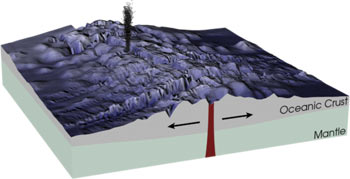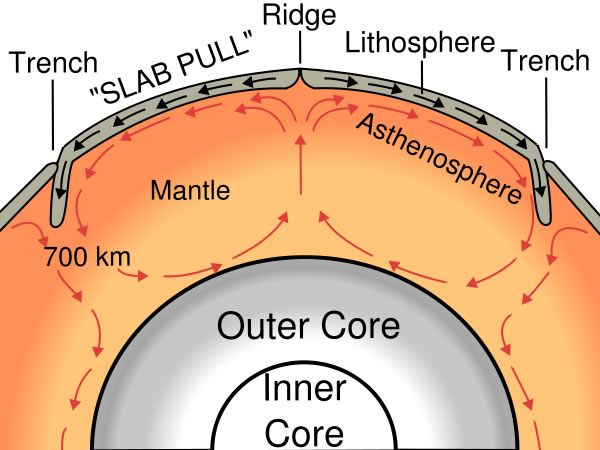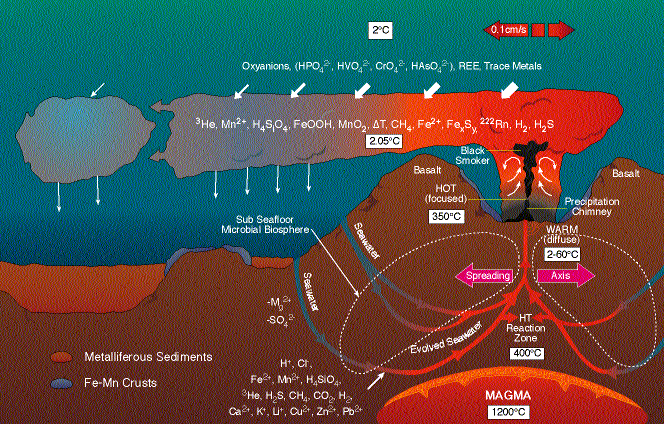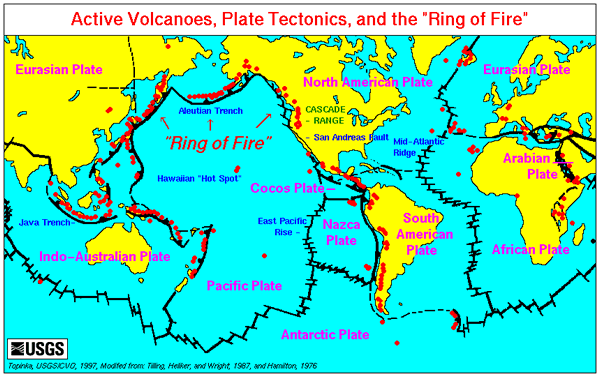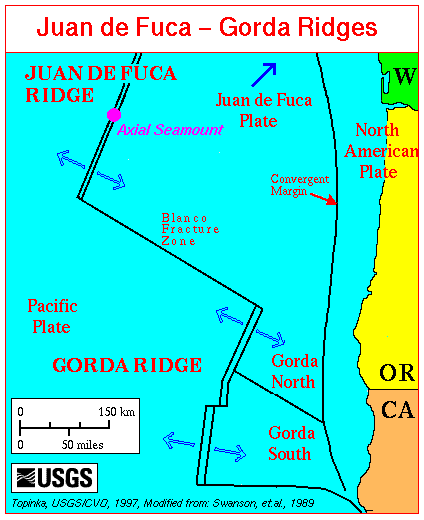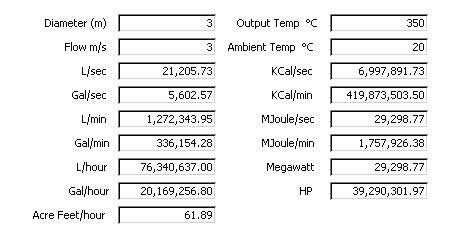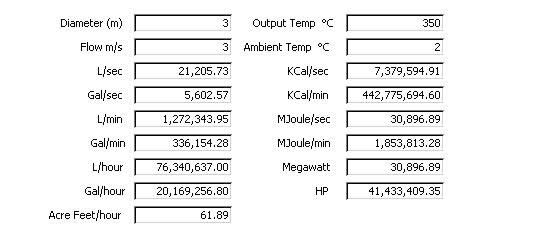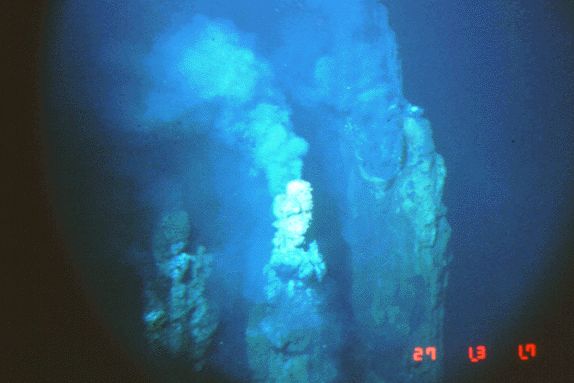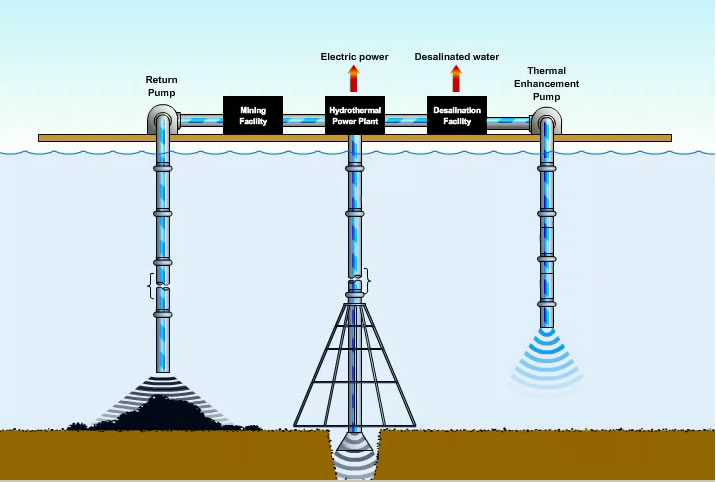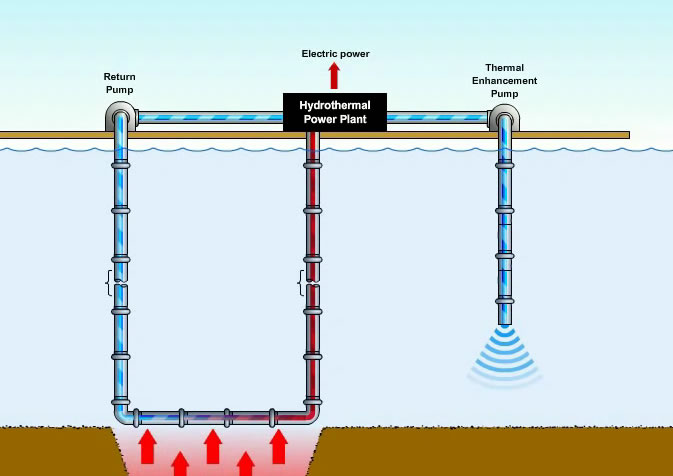

 |
 |
 |
 |
 |
 |
 |
|
The Complete Description Deep below the surface of the world's oceans, lies a vast and inexhaustible energy source, completely untouched by humans. Capable of providing enough power to make 20 GW+ generating stations a realistic expectation, its exploitation has only been awaiting the moment that a practical means of utilizing it could be developed. Encircling the Earth, our longest continuous mountain range extends over 65,000km (80,000 km if you include non-contiguous mountains), and yet it doesn’t even have one official name. This system interconnects every ocean of the world like a seam around a baseball.
Black
lines show the boundaries of tectonic plates around the earth. The
points where plates Collectively called Mid-Ocean ridges, they are a product of plate tectonics, the points at which the continental plates are pulling away from each other at a divergent boundary. Islands sometimes form where the ridges extend above sea level. Iceland, Bermuda, the Azores, and Tristan da Cuhna are products of the Mid-Ocean Ridge system.
As the plates separate from each other, magma rises from within the earth to fill the gap. The plates are moving away from each other at about the same rate that human fingernails grow, about 2 cm a year. As they stretch and weaken, a complex convection process fills the gap between the plates with new volcanic crust drawn from the earth's magma.
Oceanic crust is formed at an oceanic ridge, while the lithosphere is subducted back into the asthenosphere at trenches. It is this intense volcanic activity along these ridges that results in a phenomenon known as hydrothermal vents. Deep ocean pressures force seawater through cracks in the crust of the earth, where it ultimately makes contact with the magma. That water is eventually vented back into the ocean in a continuous geyser of superheated water (hereafter referred to as "fluid" because of the chemical changes it undergoes while in contact with the magma), exiting at velocities of 1-5 m/sec and at temperatures of 200-400° C (400-750° F), hot enough to melt lead.
A
"black smoker". The "black smoke" consists of
an abundance of dark, Although the temperatures are extremely hot, the high (225 bar or 3,200 psi) ambient pressure keeps the fluid from boiling, and the liquid fluid’s contact with 2° C or colder surrounding seawater causes a fantastic, uninterrupted and uninterruptible cocktail of metals and minerals to precipitate out of the fluid and rain down upon the seabed below. The precipitate includes iron, gold, silver, copper, zinc, cadmium, manganese, and sulfur, along with significant amounts of methane gas mixed into the fluid. Halides, sulphates, chromates, molybdates and tungstates are also abundant. For this reason, the best surface mines are located over hydrothermal veins of the geologic past.
The energy available is simply immense, far beyond anything ever before harnessed by mankind. National Geographic estimates the energy escaping from just the known vents to be 17,000,000 MW, an amount that approximates all human consumption on the planet, and there are tens of thousands of kilometers of ridge system that have never even been explored.
The
red dots are known hydrothermal and geothermal locations worldwide.
This is only a partial map, since there Ever since the long-postulated hydrothermal vents were first confirmed in 1977, every observer has understood the vast energy content of the fluid, but no one has had the slightest idea of how to utilize this amazing natural phenomenon. What kind of equipment could be used 2,300 m below the surface? How could it be serviced? The problems of hostile environment, inaccessible locations, and the impossible demands placed on equipment by any imagined utilization scheme seemed to be insurmountable, leaving this magnificent resource untouchable at the bottom of a cold, dark sea. Until now. Southern California inventor Bruce C. Marshall has patented the first practical system for commercializing the energy flowing from these vents. Called the Marshall Hydrothermal Recovery System, it literally has the potential of revolutionizing electric power generation worldwide. It starts with a deceptively simple system of insulated pipes and a funnel. Rather than attempting to deal with the superheated hydrothermal fluid at the bottom of the ocean, the heart of the Marshall System lies in ducting that fluid to the surface to be processed on platforms similar to those used for oil exploration and drilling. The logic is inescapable. If the fluid is trapped when it is hot and is maintained within an insulated structure, it can do nothing but stay hot and rise. It would move through the pipe by a combination of vent flow velocity, convection, conduction, and flash steam pressure generated as the superheated fluid rises and the ambient pressure diminishes. A funnel mouth at the input end would act as a venturi to increase flow velocity within the pipe. The fluid would be utilized at the surface by providing the heat for traditional steam turbine generation. The superheated fluid would either be used directly or it could heat a clean working fluid within a heat exchanger to ultimately drive the turbines. It could also be used with more exotic technologies such as thermoelectric generation or even magneto-hydrodynamics, or several or all of the technologies could be combined to drain every last watt that the heat energy contains. The Marshall System provides the vehicle to deliver a continuous, high-volume stream of superheated fluid to the surface, and once there, it's up to the discretion of system operators to decide how best to utilize it. To appreciate the astonishing scale of the Marshall System's potential, one needs to first appreciate the astonishing scale of the vents themselves. On the Juan de Fuca Ridge for example, which lies about 200 miles off the coast of Seattle, the main active vent field is about 180 m wide and 350 m long. Within that field are more than 15 large [up to 30 m in diameter and >20 m in height], actively venting structures and numerous smaller, less active or inactive structures.
In order to find out what the energy potential of various sites would be, Marshall wrote a computer program to do the calculations. Simply entering the parameters of pipe size, flow rate, and temperature provides the predicted outputs. The inputs used are based on numbers provided by such reputable sources as the USGS, NOAA, NASA, and Woods Hole Oceanographic Institution. They show the temperature of vents on the Juan de Fuca Ridge at 380°C (716°F). They also show flow rates ranging from 3-5 m/second. Those are the numbers chosen to use to visualize the amount of energy available for recovery from the vent system. Choosing a 3m diameter, and a 3m/second flow rate, along with a 360°C fluid temperature at the surface were all reasonable assumptions based on actual measurements. When considered against a 20°C ambient temperature, an incredible 30 GW of heat energy is being brought to the surface.
While only a portion of that will be convertible to electrical energy, the raw power can easily be put into perspective. The largest power plant of any kind in the U.S. is the nuclear plant at Palo Verde, Arizona, and its output is slightly less than 4 GW, while Hoover Dam’s output is about 2 GW. A hydrothermal plant based on these figures potentially has an output that is an order of magnitude greater than hydroelectric, and at least five times greater than nuclear. The generating capacity of the whole state of Florida is about 48 GW, and the raw energy available from one three-meter pipe is equal to 62% of that. The source of the fantastic numbers becomes evident when it's noted that 76,000,000 liters of superheated fluid is brought to the surface every hour. When one considers the energy content of nearly a superheated swimming pool brought up every second, it's easy to see why the numbers are as high as they are. 20 GW or even larger renewable energy power plants are truly on the immediate horizon. That's enough to power 20 million homes. The mathematics used for the energy calculations are straightforward. At a flow rate of 300 cm (3 m) per second, a pipe with an area of 1 cm2 would deliver 300 cc, or .3 liters of water per second. A 3 m diameter pipe has an area of 70,685 cm2, so that would translate to 21,205 liters per second of volume. If one considers the amount of heat it took to raise the water to a given temperature, we can also know how much energy it contains. If one calorie is the amount of energy it takes to raise 1 gram of water by 1o C, then it would take 21,205,000 calories/second to raise the one-second flow volume by the required 1o C. To create a 330o differential between water and ambient temperature would therefore need 7 Gcal/second of heat energy in, and it also graphically demonstrates just how much energy is available for recovery. That same amount of energy, expressed in terms of a nuclear explosion, would total about 605 kilotons over the course of one day. Another deceptively simple innovation of the system is what Marshall refers to as a Thermal Enhancement Pipe, a device that requires almost no maintenance. There is a layer in any deep body of water called the thermocline, above which the water is relatively warm, and below which the water is always very cold. This occurs because sunlight, and its warming effect, will only penetrate a relatively short distance into the sea. Currents, wind, and other activity mix that water and the upper layer is created. However, below that point, the water is so cold and dense that it simply has no energy to rise, so it stays there, unable to break through the thermocline to the warmer layer above. The Thermal Enhancement Pipe is nothing more than an insulated pipe open at both ends like a huge drinking straw, with the surface end extending several feet out of the water to prevent the contents mixing with the surrounding seawater, and the bottom end extending down below the thermocline. Water is pumped from the surface within the open pipe, and as it is withdrawn, it is refilled by atmospheric pressure at the only point open to the sea, with frigid water from the bottom. Once water is withdrawn from within the pipe, it can only be replaced by extremely cold water from below the thermocline, and within a very short time the pipe will contain nothing but water just a degree or two above freezing. Since thermal energy availability is determined by the temperature difference between two points, by using the water withdrawn from it for the cold side of any thermal extraction process, this very simple device adds at least 1.5 GW to the expected output of the system, and yet it consumes no more energy than would be required to pump water from the sea surface to the platform height where energy extraction would take place. This minor addition increased the plant's potential output by 1.5 GW, a virtually free add-on that is more powerful in itself than the output the great majority of plants currently operating in the U.S.
While the 3 meter pipe diameter was chosen for discussion only because it seemed a reasonable size to work with, there is nothing to stop even larger sizes from being used as long as they can be dealt with practically. The only physical limitation on the system is what the real world of manufacturing and pipe handling will allow. If a vent system could support the necessary volume of flow, and one allows for a 4-meter pipe, the numbers appear to come straight out of a science fiction novel about nuclear fusion.
That single 4-meter pipe would deliver an astronomical 53 GW of raw energy to the surface. And that number comes from using a 20°C ambient temperature. If the Thermal Enhancement Pipe is used, the available energy increases to a mind-boggling 56 GW, or 75 million horsepower. Even with a concept like that of the Marshall System, how does one stand a pipe up in the middle of a 30 m wide hole in the ocean floor? The Marshall System includes a conical base structure that is large enough to surround the vent, which would allow the recovery pipe to pass down through the center of it as deep into the vent as practical to recover fluid at the hottest possible temperatures. Then pipe sections are added one at a time, with the weight of the column of pipe supported by the cone structure itself.
The
Marshall System's base is constructed of highly stable circles and
triangles. The horizontal support arms only take the The funnel at the intake end is designed to act like a venturi to increase the velocity of the fluid within the pipe. A detailed topographical mapping of the area surrounding the vent would be done, and a reverse matching contour would be built into the underside of the bottom ring. That would allow a stable, level surface upon which to build regardless of the irregularity of the sea floor below it. Weight was an issue that received serious consideration. One section of insulated 3m pipe, 3m long would clearly weigh more than a ton, and with 700 or more sections added together to reach the surface, the support stucture would have a hefty load to bear. A
further source of concern was vertical stability. With a height
more than 800 times the diameter of the base, the pipe column was
an extremely unstable shape that would topple over long before it
ever reached the surface. Both problems were minimized with one
simple expedient.
Hydrothermal vents also come in many different shapes and sizes. The giant vents of the Juan de Fuca Ridge are the exceptions, but many are quite small, 20 cm (8 inches) across or so. They are often found in close proximity to each other within a confined geographical field. Another problem that had to be addressed was making the system work under these conditions as well.
A hydrothermal vent field showing several active vents in close proximity to each other. In the end, an almost identical solution was settled upon, utilizing the same type of conical structure, but instead of a single pipe it would employ multiple recovery pipes and a manifold to combine the outputs of the different vents into one single pipe for transit to the surface. With the bottom ring approximately the same size as for the large vents, 30m or more in diameter, an area of over 700 m2 (7,800 ft2) would be under the framework. That is room enough to capture and combine the fluid from a lot of small vents in a dense field.
Base configuration for capturing the output of many small vents and combining it into a single pipe through a manifold. It was apparent from the beginning that along with the superheated fluid would come the incredible mineral cocktail mentioned earlier, and Marshall has patented not only the first hydrothermal energy system, but also the first practical deep sea mining system. It is envisioned that the slurry that remains after the heat has been extracted would be either processed on-site or loaded aboard ships for processing elsewhere. Removal of valuable metals and minerals from the slurry will be far easier than trying to mine them from the ground because of their extremely high concentrations, and because they are being delivered to the mine operators along with the hydrothermal fluid rather than being forcibly pulled from the earth.
The
complete Marshall Hydrothermal Recovery System, showing electric
generation, water desalination, and mining Donut shapes on the pipe segments are buoyancy collars to reduce weight total and increase vertical stability. A Waste Return Pipe has also been included because there is certain to be an unneeded byproduct of the mining and energy production system that will require removal. It’s simply a pipe extending deep down from the platform through which leftovers from the mining operation can be disposed. This should not be considered as a source of pollution, since what is being returned through the Waste Return Pipe came from the sea in the first place. Strict safeguards need to be implemented to assure that real pollutants are not disposed of through the return system, but the logic of sending extraneous natural materials back where they came from is inescapable. While energy and mining are of themselves ample reason to build the Marshall Hydrothermal Recovery System, there is one more benefit that became obvious as it was being developed. The immense volume of superheated fluid that would be brought to the surface would spontaneously flash to steam as pressure is released, and it was a small leap to realize that the steam can be distilled back into fresh water. It became quite obvious that this is also a water desalination system unlike any previously conceived. While some measure of further processing is likely to be required after distillation, incredible volumes of water could be made to be quite pure with little additional effort and energy input. The key is in the figures for a 3m pipe that show 76 Ml of water being brought to the surface every hour. Even when using a very conservative figure of only 50% of it recovered as fresh water, the total figure is still just short of a billion liters of water a day. A closed loop system was also developed that would heat a clean working fluid in a heat exchanger positioned over the vent. It would then be sent to the surface for energy extraction, and would be returned back to be reheated and start the cycle again. Because the hydrothermal fluid itself is not brought to the surface, mining is not possible in this configuration, but there are some strong advantages to it as well. Any system that directly uses hydrothermal fluid will have to deal with the technical issues that would surround the utilization of a potentially corrosive, high-velocity, superheated fluid containing particulate matter. The closed-loop system completely obviates any of those concerns. The only product dealt with is superheated clean working fluid.
In
this closed loop configuration, the Marshall System does not actually
bring the hydrothermal fluid to the surface. Instead, Some have expressed a valid concern about environmental issues, since hydrothermal vents are home to an amazing variety of life forms that are unknown anywhere else on earth. Rather than using photosynthesis, they use chemosynthesis to produce energy in the depths where no light is available.
These
blood-red tubeworms are one form of life that flourishes in the
chemical-rich environment surrounding The best method of dealing with the life encountered is to simply transplant a sample of each unique form to another nearby vent where it can continue to thrive, but it can also be considered reasonable to ignore the life forms completely and allow them to perish. Although that may seem to be a barbaric approach to anyone with an environmental conscience, it must be realized that vents open and close by nature all the time, and the natural cycle will have all the life forms around any given vent system die at some point even if there is no human intervention of any kind. This process has been going on uninterrupted since the earliest evolutionary days of our planet. It seems that life regenerates spontaneously as new vents are formed. This was noted in a Rutgers University study that showed a remarkable regeneration only nine years after an undersea volcanic eruption sealed some known vents and killed all the surrounding life. It is also important to recognize that the number of untouched natural vents that will remain with their ecosystems intact would dwarf the tiny overall percentage of vents that might ever ultimately be tapped for human use. Only by keeping the incredible scale of the Earth's tectonic plate system in mind can that fact be adequately appreciated. The Marshall System seems to have a Jules Verne quality about it, but the fanciful ideas are based on science fact, not science fiction. There is no technology used that has to be developed from the ground up, even if some may have to be modified for this application. It marries the existing technologies of deep-water oil platforms, electric generation, undersea cables, water desalination, and pipe laying and manufacture. The Marshall System is really no farther into the future than the time involved in decision making, securing of financing, engineering, production lead-time, and construction. It is almost inevitable that it will be producing energy, minerals, and fresh water somewhere in the world within five years if a concerted effort to do so is made.
Update:
Seawater Specific
Gravity 1.03
83 MW energy
producible
|



